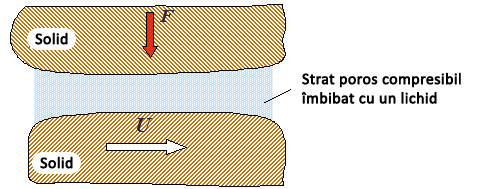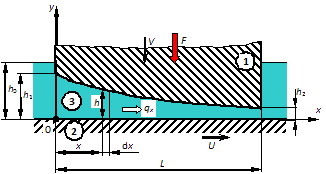
![]()

Last updated
April 26, 2010
Page created by
Luiza CICONE

During the last 10-15 years a new lubrication mechanism applicable to highly compressible porous layers acting as self-sustained films has been developed (Fig.1). This lubrication process was observed and analyzed independently by professor Pascovici from University Politehnica of Bucharest and professor Weinbaum from City University of New York.
This type of lubrication is strongly dependent on porosity variation and consequently on permeability hence, the name ex-poro-hydrodynamic-XPHD lubrication was proposed by professor Pascovici [1].
The applications foreseen until present by professor’s Pascovici research team referred to: viscosity pumps [2], thrust bearings [1], red cells lubrication in narrow capillary circulation [3] and the study of squeeze phenomenon in the case of natural or artificial human joints [4].
The applications of the professor’s Weinbaum research team referred to the lubrication processes with applications on snow skiing [5], circulation of the red cells in narrow capillaries [5], [6], [7] and even in the case of high-speed trains [6].
Basically, this means flows in a porous medium whose solid phase, represented by fibers, induce elastic compression forces which are negligible compared to the hydrodynamic pressure forces generated in the interior of the porous medium.
Both in technique, as well as in the living world, there are a lot of examples of structures which lead to creating such layers: textile unwoven materials, such as felt or cloths; recently fallen snow; birds down; endothelial layers of glycocalyx which cover capillaries; articular cartilage; etc.
 |
| Fig. 1. General presentation of XPHD lubrication |
At the basis of the explanation of the XPHD phenomenon consists in the following succession of correlations: the variation of the layer thickness in space and time leads to a variation of porosity and permeability, which leads finally to the appearance of the stationary pressure field, or variable in time.In order to mathematically model the phenomenon involved, it is accepted by all authors that the porous structures of this type are Brinkman mediums [8] which, for low permeability, can be approximated with Darcy mediums [8]. The classical assumptions in this case are:
- The fluid imbibed in the porous layer is Newtonian and the flow is laminar and isothermal/isoviscous;
- The porous layer is thin and the pressure across its thickness is constant;
Additionally, all authors from this research field accept the assumption of the conservation of the solid fraction on the film thickness :
Considering ε the relative porosity and by σ the relative compacticity, the following relationship is considered:
 (1)
(1)
 (2)
(2)
In order to express the variation of the permeability ø with the porosity ε, two alternatives were employed:
The research team of prof. Pascovici employed the relation Kozeny-Carman [8] in order to express the relation between permeability and porosity:
 (3)
(3)
where  and
and  is the diameter of the fibers which compose the porous layer.
is the diameter of the fibers which compose the porous layer.
This corellation was validated recently by an extremely detailed study for 2D structures and in 3D extension, for porosities between 0.2 < ε < 0.8 [9]. The relation Kozeny-Carman appears in modeling the flow in the case of the brush seals [10].
Professor’s Weinbaum research team imagined a 2D porous regular structure, deformable in a deterministic way, for which he calculated the variation of the permeability with the porosity respectively the level of deformation. [5]. Subsequently he used a deformable structure of the type „brush 2D”, applied to the glycocalyx layers, for the study if the lubrication of red cells in narrow capillaries [7].
 |
| 1 & 2 - rigid components 3 - porous extremely compressible layer imbibed with fluid/lubricant solidary with component 2 |
| Figura 2. Schematic of the XPHD configuration |
Essentially, for a configuration as presented in Fig. 2, respectively for a convergent porous layer, with tangential U motion and normal V motion, the Reynolds equation which corresponds to this type of XPHD lubrication is [11]:
 (3)
(3)
Solved for different kinematic schemes and configurations, analytically for 1D problems and numerically for 2D problems, the equation (4) allows the determination of the pressure distribution and load carrying capacity. The solutions found over time are presented in Table 1.
| Movement/Effect | Configuration | Year of publication |
| Tangential/Wedge effect | Stepped | [1] - 2001 |
| Plane-inclined | [11] - 2007 | |
| Normal/Squeeze effect | Plane-circular surfaces | [4] - 2003 |
| Spherical surfaces | [4] - 2003 |
Tab. 1. XPHD couples studied by the research team of prof. Pascovici
Comparing the performances of load carrying capacity for the XPHD regime with the classical HD regime, utilizing the same configuration and the same cinematic, the conclusion is unanimous, as presented in the professor’s Pascovici research team papers, [1], [4], [11], and in professor’s Weinbaum research team papers [5], [6]: the load carrying capacity in XPHD conditions in 3-4 times greater compared to the case of the classical HD case!
Figure 3 presents the image of a demonstrative experiment and the corresponding device, using as a porous material a wash-cloth and water as a lubricant. The experiment took place on a stepped pocketed slider with tangential movement. By this experiment it was illustrated that even at small speeds, the XPHD pressure distribution exists, being of the order of a couple of bars
Experimental studies in XPHD conditions exist, but they are not complitely studied, especially in connection with the fabrication of compliant and porous materials and the control of their properties. The assessment of the permeability and of its variation with porosity represents one of the main difficulties of the experimental part.




